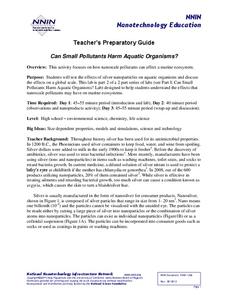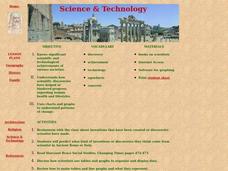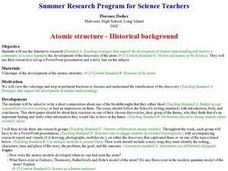Curated OER
Digging up the Past
Students explore history through archaeology. In this critical analysis lesson, students work in teams to recreate a model of the archaeological discoveries made in the excavations at Monticello. This lesson is designed to help students...
Curated OER
Shoot for the Moon
Second graders distinguish the different phases of the moon. In this astronomy lesson, 2nd graders study the history of its discovery and myths about its origin. They simulate how the moon's surface is illuminated by the sun.
Curated OER
What Is the Nature of Science?
Students distinguish between scientific and everyday meanings of key words-theory, hypothesis, law, fact-and use in context. They recognize the variables that affect observation, data collection, and interpretation. They discover the...
Curated OER
Where Does Maple Syrup Come From?
In this maple syrup learning exercise, students read an informational article about the discovery of maple syrup, how we get maple syrup today, the "sugar house", how to grade it, and a recipe for a snow cone. Students answer nine true...
Curated OER
Brown Bag Science
Students discover, through the discovery method, how electricity works. They construct a simple circuit and a parallel circuit, make an electrical motor work and add a switch to turn it on and off.
Curated OER
Learning the Basic Levers...One, Two, Three: Different Basic Arrangements Levers
Fifth graders read information about levers. They complete worksheets to summarize their learning. This lesson relies heavily on the Silver Burdett Ginn text, Science Discovery Works, Energy, Work, and Machines. The lesson will not be...
Curated OER
Diversity in Insects
Second graders examine bug photos from across the world. In this biodiversity instructional activity, students use a field notebook to make observation of insect photos. The class gather on the floor to investigate a...
Serendip
Introduction to Osmosis
A chicken egg is a very large cell—perfect for investigating osmosis! Scholars conduct an experiment with vinegar and eggs that helps them understand the process of osmosis. They follow the activity with an in-depth look at osmosis...
American Museum of Natural History
Around the World with DNA
DNA analysis could be what saves some animals from extinction. An interactive lesson shows learners how DNA information proves variation among animals of the same species and how stakeholders use that information to make decisions. Easy...
West Contra Costa Unified School District
Introduction to Trigonometric Functions
Scholars first learn the definitions of the sine ratio, the cosine ratio, and the tangent ratio. After mastering these definitions, they use the new information to solve triangles.
National Nanotechnology Infrastructure Network
Can Small Pollutants Harm Aquatic Organisms?
Nanoparticles have toxic effects on plant and animal life—even though you can't see them. The second instructional activity of a two-part series has young scientists conduct an experiment that exposes plant and animals to nanoparticle...
Curated OER
Science and Technology
Pupils research inventions that have been created. In this historical technology instructional activity, students read the Harcourt Brace social studies textbook and discuss how inventors used graphs to display data. Pupils create a...
Curated OER
Applied Science - Technology Pre - Lab (inventions)
Students read the book Icky, Sticky Gloop by Morgan Matthes. In this scientific exploration activity, students compare the fictional character in the book with Benjamin Franklin (both are inventors). They discover why and how inventions...
Curated OER
Who Owns The Past?
Students research the validity and legality of ownership. Through the use of primary sources, web based and print media research, students become familiar with and evaluate the varying viewpoints regarding the...
Curated OER
What Kind of Insect is That?
Fifth graders characterize insects and classify insects according to the Linnaean system. They use hand lenses or microscopes to examine insect body parts.
Curated OER
Scientific Who's Who
Eighth graders research a scientist from a specific culture or time period.
Curated OER
Cloud Discovery
Students create a slideshow that pictorially depicts a variety of cloud types. They research clouds, develop and present the slideshow and then evaluate their efforts based on a rubric for self-evaluation.
Curated OER
A Journey of Discovery with RXTE
Students complete different missions to examine the topic of x-ray sources. They use satellite images and websites to gather the information they need to complete the lesson. They complete a worksheet to end the lesson.
Curated OER
Lewis and Clark: The Language of Discovery
Students replicate some of the trailblazing methods of Lewis and Clark on a fifteen-minute "writing journey" through the school or neighborhood.
Curated OER
Inventors and Scientists
Students research a scientific breakthrough. In this science lesson, students write an essay on a technology that has changed the world.
Curated OER
Atoms: The Building Block of Matter
Learners examine how scientific theories are developed. In this matter lesson plan, students explore the basic idea of quantum theory. They create a timeline of scientists, their contributions, and discoveries.
Curated OER
Pill Bug Extravaganza
Tenth graders watch a PowerPoint presentation to review the scientific process. They examine pill bugs before designing an experiment to find new discoveries about these Crustaceans. They complete ten lessons in this unit.
Curated OER
Atomic structure - Historical background
Pupils use the Internet to research the development of the discovery of the atom. They create an essay, PowerPoint presentation and a story line on the subject.
Curated OER
Smallville Prairie Development Project
Students research the characteristics of the prairie habitat focusing on scientific, social/historical and aesthetic values. They investigate how humans impact the prairie habitat while maintaining a daily journal of research and...























